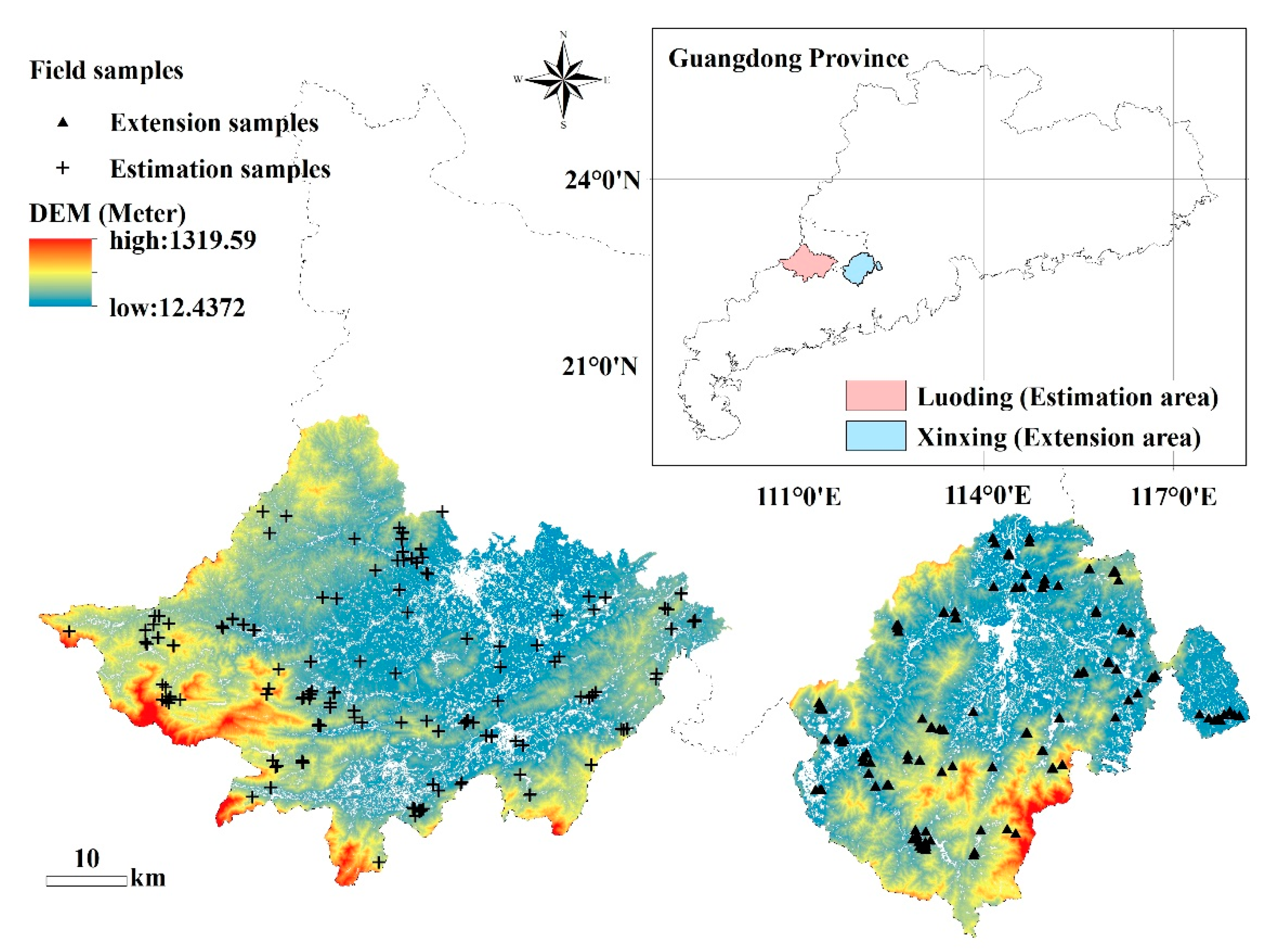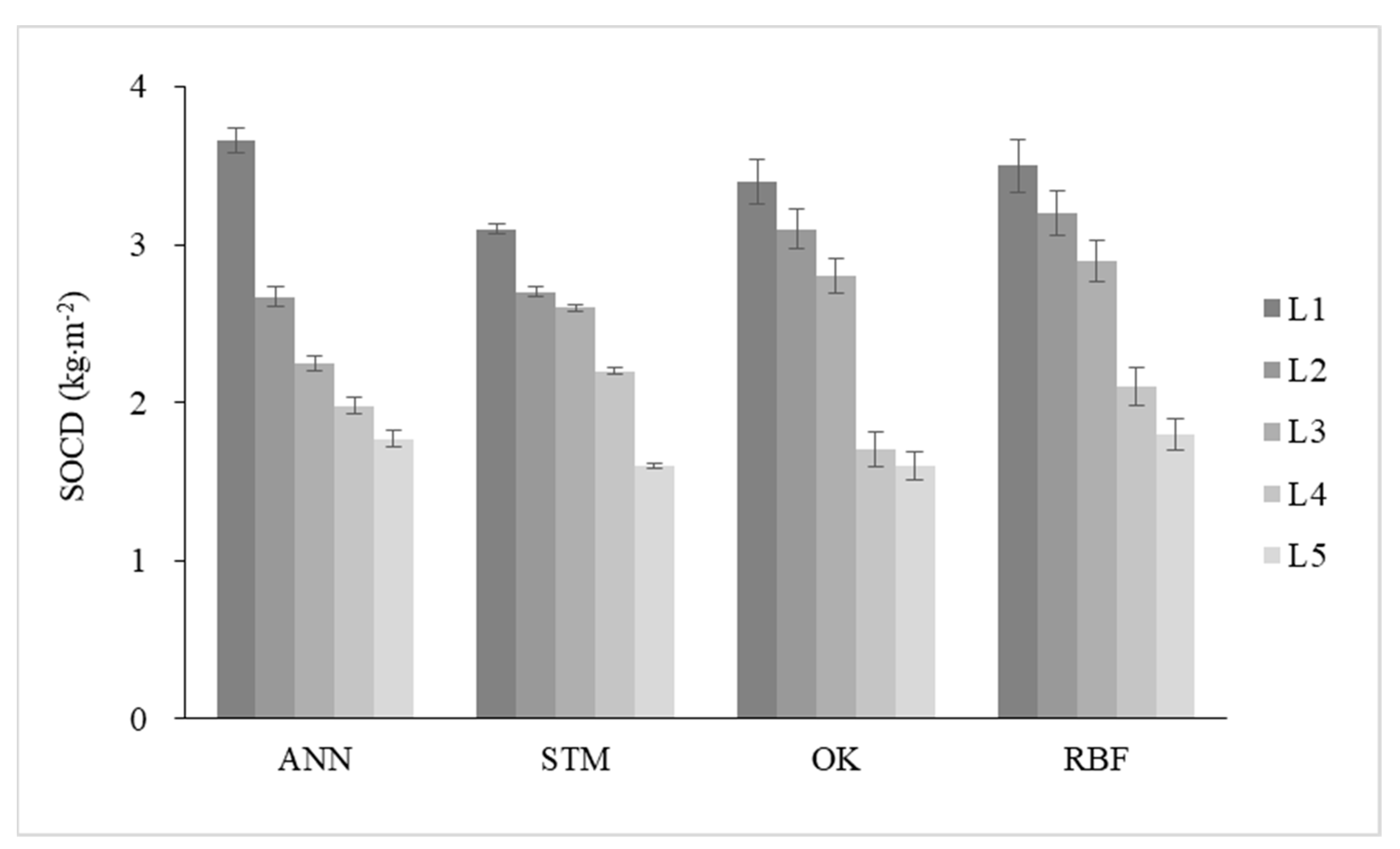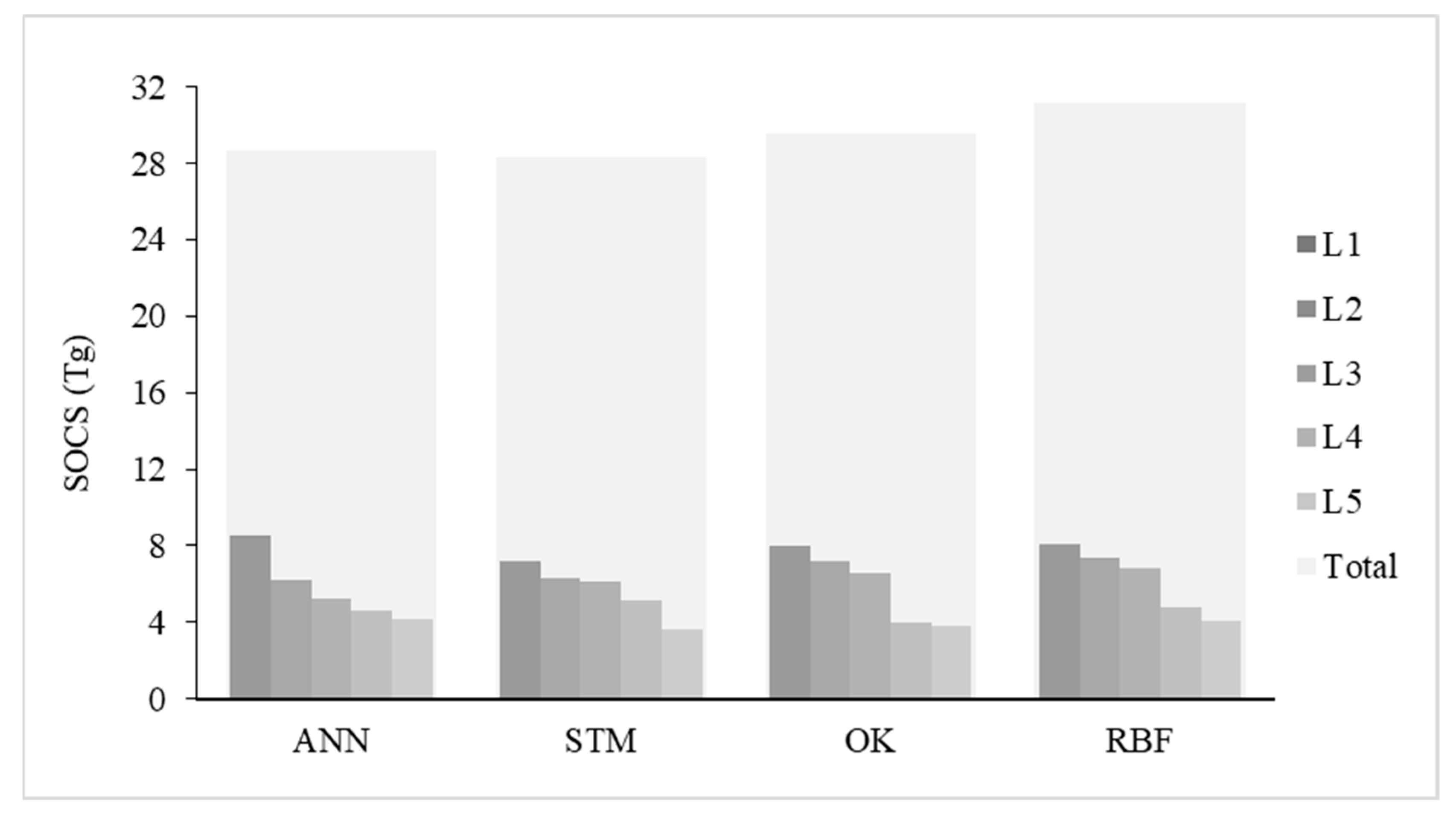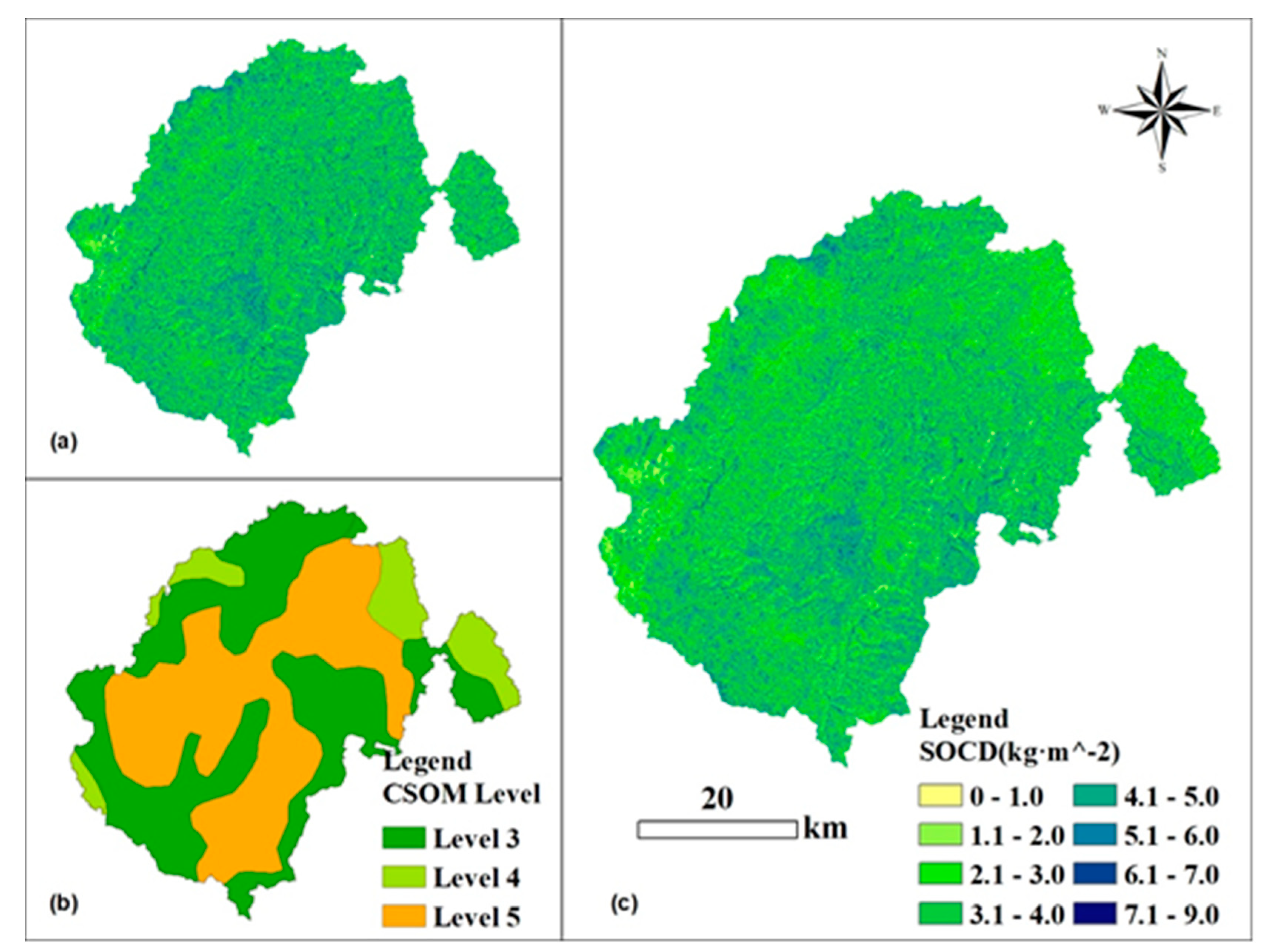A Two-Stage Approach to the Estimation of High-Resolution Soil Organic Carbon Storage with Good Extension Capability
Abstract
1. Introduction
2. Materials and Methods
2.1. Study Area
2.2. Field Sample
2.3. Other Data and Materials
2.4. The First Stage: SOCS Estimation Methods
2.4.1. The Artificial Neural Network (ANN) Estimation Method
2.4.2. The Common Estimation Methods
2.5. Extension Test of the Four Estimation Methods
2.6. The Second Stage: The Linear Model for Extending the ANN Estimation Method
2.7. Accuracy Assessment
3. Results
3.1. Statistical Characteristics of the Field SOCD
3.2. The First Stage: SOCS Estimation Methods
3.2.1. Accuracy of SOCS Estimation Methods
3.2.2. Results of SOCS Estimation Method
3.2.3. The Correlation between ANN Model Parameters and the Predicted SOCD
3.2.4. Spatial Mapping of SOCD Estimation Methods
3.3. Extension Results of SOCD Estimation Methods
3.4. The Second Stage: The Linear Model
3.4.1. Coefficients and Accuracy of the Linear Model
3.4.2. Spatial Distribution Maps of the Extended Area
4. Discussion
4.1. Estimation Capability of the Four Methods
4.2. Extension Capability of ANN Model Estimation Method
4.3. SOCS Vertical Distribution of the Estimation Area
5. Conclusions
Author Contributions
Funding
Institutional Review Board Statement
Informed Consent Statement
Data Availability Statement
Conflicts of Interest
References
- Zhou, M.; Xiao, H.; Nie, X. Analysis and Prospect of Soil Organic Carbon Research Process in Recent 30 Years at Home and Abroad. Res. Soil Water Conserv. 2020, 27, 395–404. (In Chinese) [Google Scholar]
- Sun, W.; Liu, X. Review on carbon storage estimation of forest ecosystem and applications in China. For. Ecosyst. 2020, 7, 37–50. [Google Scholar] [CrossRef]
- Song, Y.; Wang, K. Research progress of Forestry Ecosystem Soil Carbon Storage Accounting Methods at Home and Aboard. J. Green Sci. Technol. 2018, 1–6. (In Chinese) [Google Scholar] [CrossRef]
- Post, W.M.; Emanuel, W.R.; Zinke, P.J.; Stangenberger, A.G. Soil carbon pools and world life zones. Nature 1982, 298, 156–159. [Google Scholar] [CrossRef]
- Hengl, T.; Heuvelink, G.B.M.; Rossiter, D.G. About regression-kriging: From equations to case studies. Comput. Geosci. 2007, 33, 1301–1315. [Google Scholar] [CrossRef]
- Bhunia, G.S.; Shit, P.K.; Maiti, R. Spatial variability of soil organic carbon under different land use using radial basis function (RBF). Model. Earth Syst. Environ. 2016, 2, 17. [Google Scholar] [CrossRef]
- Lei, X. Applications of machine learning algorithms in forest growth and yield prediction. J. Beijing For. Univ. 2019, 41, 23–36. (In Chinese) [Google Scholar]
- Li, Q.; Yue, T.; Fan, Z.; Du, Z.; Chen, C.; Lu, Y. Spatial simulation of topsoil TN at the national scale in China. Geogr. Res. 2010, 29, 1981–1992. (In Chinese) [Google Scholar]
- Xu, L.; Yu, G.; He, N.; Wang, Q.; Gao, Y.; Wen, D.; Li, S.; Niu, S.; Ge, J. Carbon storage in China’s terrestrial ecosystems: A synthesis. Sci. Rep. 2018, 8, 2806. [Google Scholar] [CrossRef] [PubMed]
- Kennedy, W.; Dieu, T.B.; Dick, Ø.B.; Singh, B.R. A comparative assessment of support vector regression, artificial neural networks, and random forests for predicting and mapping soil organic carbon stocks across an Afromontane landscape. Ecol. Indic. 2015, 52, 394–403. [Google Scholar]
- Huang, Y.; Guo, Z.; Wu, Z.; Chai, M. Accuracy Analysis of Soil Organic Carbon-A Case Study of Guangdong Province, China. Chin. Agric. Sci. Bull. 2014, 30, 300–307. (In Chinese) [Google Scholar]
- Miao, Z.; Yang, Q.; Qiu, Z.; Bi, Q.; Wang, Z. Impact of Land Use Change on Soil Organic Carbon Stocks Based on GIS-A Case Study in Fujin City. Res. Soil Water Conserv. 2015, 22, 19–23. (In Chinese) [Google Scholar]
- Martín, J.R.; Álvaro-Fuentes, J.; Gonzalo, J.; Gil, C.; Ramos-Miras, J.; Corbí, J.G.; Boluda, R. Assessment of the soil organic carbon stock in Spain. Geoderma 2016, 264, 117–125. [Google Scholar] [CrossRef]
- Chen, Q.; Wang, S.; Yu, G. Spatial characteristics of soil organic carbon and nitrogen in Inner Mongolia. Chin. J. Appl. Ecol. 2003, 14, 699–704. (In Chinese) [Google Scholar]
- Yu, D.; Shi, X.; Sun, W.; Wang, H.; Liu, Q.; Zhao, Y. Estimation of China soil organic carbon storage and density based on 1:1,000,000 soil database. Chin. J. Appl. Ecol. 2005, 16, 2279–2283. (In Chinese) [Google Scholar]
- Luo, W.; Zhang, H.; Chen, J.; Liu, Y.; Li, D. Storage and spatial distribution of soil organic carbon in Guangdong Province, China. Ecol. Environ. Sci. 2018, 27, 1593–1601. (In Chinese) [Google Scholar]
- Batjes, N.H. The total C and N in soils of the world. Eur. J. Soil Sci. 1996, 47, 151–163. [Google Scholar] [CrossRef]
- Hengl, T.; de Jesus, J.M.; MacMillan, R.A.; Batjes, N.H.; Heuvelink, G.B.M.; Gerard, B.M.; Ribeiro, E.; Samuel-Rosa, A.; Kempen, B.; Leenaars, J.G.B.; et al. SoilGrids1km—Global Soil Information Based on Automated Mapping. PLoS ONE 2014, 9, e105992. [Google Scholar] [CrossRef]
- Liu, X. Research on Spatial Interpolation Methods of Reclaimed Soil Organic Carbon and Optimization of Monitoring Samples-Taking Pingshuo Mining Area of Shanxi as an Example. Master’s Thesis, China University of Geosciences, Wuhan, China, 2015. (In Chinese). [Google Scholar]
- Huang, C.; Zhang, J.; Yang, W.; Zhang, G.; Wang, Y. Spatial distribution characteristics of forest soil organic carbon stock in Sichuan Province. Acta Ecol. Sin. 2009, 29, 1217–1225. (In Chinese) [Google Scholar]
- Zhao, Z.; Yang, Q.; Sun, D.; Ding, X.; Meng, F.-R. Extended model prediction of high-resolution soil organic matter over a large area using limited number of field samples. Comput. Electron. Agric. 2020, 169, 105172. [Google Scholar] [CrossRef]
- Zeng, M.; Zhang, Z.; Li, X.; Ding, X.; Zhang, G.; Hua, Y.; Qi, Y. Soil calcium, magnesium and sulfur content of Camellia oleifera suitable areas in Yunfu City, For. Environ. Sci. 2017, 6, 102–107. (In Chinese) [Google Scholar] [CrossRef]
- Li, X.; Ding, X.; Ceng, S.; Zhang, C.; Yang, H. Forest Soil Survey of Yunfu, Guangdong Province; China Forestry Publishing House: Beijing, China, 2018; pp. 112–124. (In Chinese) [Google Scholar]
- Wei, S.; Dai, Y.; Liu, B.; Zhu, A.; Duan, Q.; Wu, L.; Ji, D.; Ye, A.; Yuan, H.; Zhang, Q.; et al. A China data set of soil properties for land surface modeling. J. Adv. Model. Earth Syst. 2013, 5, 212–224. [Google Scholar]
- Liu, S.; Sun, Y.; Dong, Y.; Zhao, H.; Dong, S.; Zhao, S.; Beazley, R. The spatio-temporal patterns of the topsoil organic carbon density and its influencing factors based on different estimation models in the grassland of Qinghai-Tibet Plateau. PLoS ONE 2019, 14, e0225952. [Google Scholar] [CrossRef]
- Standardization Administration of the People’s Republic of China (SAC). Method for Determination of Soil Organic Matter: GB 9834–88; Standards Press of China: Beijing, China, 1988. [Google Scholar]
- Wang, S.; Zhou, C.; Li, K.; Zhu, S.; Huang, F. Analysis on spatial distribution characteristics of soil organic carbon reservoir in China. ACTA Geogr. Sin. 2000, 55, 533–544. (In Chinese) [Google Scholar]
- Zhang, L.; Zhang, J. Precise processing of Spot-5 Hrs and Irs-P5 Stereo Imagery for the Project of West China Topographic Mapping at 1:50,000 Scale. In Proceedings of the Isprs Tc VII Symposium—100 Years Isprs, Vienna, Austria, 5–7 July 2010. [Google Scholar]
- ESRI Inc. The Help Document 1999–2013; ESRI: Redlands, CA, USA, 2013. [Google Scholar]
- Meng, F.; Castonguay, M.; Ogilvie, J.; Murphy, P.N.C.; Arp, P.A. Developing a GIS-Based flow-channel and wet areas mapping framework for precision forestry planning. In Proceedings of the IUFRO Precision Forestry Symposium 2006, Stellenbosch, South Africa, 5–10 March 2006; pp. 43–55. [Google Scholar]
- Gallant, J.C.; Wilson, J.P. Primary topographic attributes. In Terrain Analysis: Principles and Applications; Wiley: New York, NY, USA, 2000; pp. 51–85. [Google Scholar]
- De Reu, J.; Bourgeois, J.; Bats, M.; Zwertvaegher, A.; Gelorini, V.; Smedt, P.; Chu, W.; Antrop, M.; Meayer, P.; Finke, P. Application of the topographic position index to heterogeneous landscapes. Geomorphology 2013, 186, 39–49. [Google Scholar] [CrossRef]
- Ferro, V.; Minacapilli, M. Sediment delivery processes at basin scale. Hydrol. Sci. J. 1995, 40, 703–717. [Google Scholar] [CrossRef]
- Meng, F.-R.; Arp, P.A.; Zelazny, V.F.; Colpitts, M.C.; Schivatcheva, T.; Fahmy, S.H. Spatial and Temporal Variation of Soil Moisture; Progress Report for Fundy Model Forest: Lower Cove, NB, Canada, 1997; p. 4. [Google Scholar]
- Murphy, P.N.C.; Ogilvie, J.; Connor, K.; Arp, P.A. Mapping wetlands: A comparison of two different approaches for New Brunswick, Canada. Wetlands 2007, 27, 846–854. [Google Scholar] [CrossRef]
- Pan, X.; Pan, K. Soil SubCenter; National Earth System Science Data Center: Beijing, China, 2015. [Google Scholar]
- Li, Z. Supervised classification of multispectral remote sensing image using B-P Neural Network. J. Infrared Milli. Waves 1998, 17, 153–156. [Google Scholar]
- Sigillito, V.G.; Hutton, L.V. Case study II: Radar signal processing. In Neural Network PC Tools; Academic Press: San Diego, CA, USA, 1990. [Google Scholar]
- Zhao, Z.; Yang, Q.; Benoy, G.; Chow, T.L.; Xing, Z.; Rees, H.W.; Meng, F.-R. Using artificial neural network models to produce soil organic carbon content distribution maps across landscapes. Can. J. Soil Sci. 2010, 90, 75–87. [Google Scholar] [CrossRef]
- Sun, D. Model Prediction of High-Resolution Three-Dimensional Forest Soil Nutrients. Master’s Thesis, Guangxi University, Nanning, China, 2020. (In Chinese). [Google Scholar]
- The MathWorks Inc. The Help Document 1984–2012; The MathWorks Inc.: Natick, MA, USA, 2012. [Google Scholar]
- Lin, K. Application Research on Generalization Capability of the Artificial Neural Network and Rainfall Forecast. Ph.D. Thesis, Nanjing University of Information Science & Technology, Nanning, China, 2007. (In Chinese). [Google Scholar]
- Wu, X.; Yan, L. Setting Parameter s and Choosing Optimum Semivariogram Models of Ordinary Kriging Interpolation-A case study of spatial interpolation to January average temperature of Fujian province. Geo-Inform. Sci. 2007, 9, 104–108. (In Chinese) [Google Scholar]
- Tang, X.; Xia, M.; Pérez-Cruzado, C.; Guan, F.; Fan, S. Spatial distribution of soil organic carbon stock in Moso bamboo forests in subtropical China. Sci. Rep. 2017, 7, srep42640. [Google Scholar] [CrossRef] [PubMed]
- Wang, Y.; Yang, Z.; Yu, T.; Wen, Y.; Xia, X.; Bai, R. Contrastive studies on different interpolation methods in soil carbon storage calculation in Da’an City, Jilin Province. Carsol. Sin. 2011, 30, 479–486. (In Chinese) [Google Scholar]
- Liu, X.; Liang, M.; Chen, L.; Wang, S.; Zheng, W.; Yu, X.; Li, R.; Zhang, G.; Wang, F.; Yang, H. Carbon storage, carbon density and spatial distribution of forest ecosystems in Hunan Province. Chin. J. Ecol. 2017, 36, 2385–2393. (In Chinese) [Google Scholar]
- Zhang, Z.; Sun, Y.; Yu, D.; Mao, P.; Xu, L. Influence of Sampling Point Discretization on the Regional Variability of Soil Organic Carbon in the Red Soil Region, China. Sustainability 2018, 10, 3603. [Google Scholar] [CrossRef]
- Kerry, R.; Goovaerts, P.; Rawlins, B.; Marchant, B. Disaggregation of legacy soil data using area to point kriging for mapping soil organic carbon at the regional scale. Geoderma 2012, 170, 347–358. [Google Scholar] [CrossRef]
- Chen, H.; Chen, Z.; Chen, Z. Impact of topography on spatial distribution of organic matters in red eroded soil in south China-A case study at hetian in Changting county. Fujian J. Agric. Sci. 2010, 25, 369–373. (In Chinese) [Google Scholar]
- Ambroise, B.; Beven, K.; Freer, J. Toward a generalization of the TOPMODEL concepts: Topological indexes of hydraulic similarity. Water Resour. Res. 1996, 32. [Google Scholar] [CrossRef]
- Yan, M.; Chen, B.; Li, Z.; Jin, W.; Yang, Y. Parameter calibration for watered hydrology model based on soil topography index and hydraulic partition of underlying surface. J. Hohai Univ. 2015, 43, 197–202. (In Chinese) [Google Scholar]
- Odebiri, O.; Mutanga, O.; Odindi, J.; Peerbhay, K.; Dovey, S.; Ismail, R. Estimating soil organic carbon stocks under commercial forestry using topo-climate variables in KwaZulu-Natal, South Africa. S. Afr. J. Sci. 2020, 116, 71–78. [Google Scholar] [CrossRef]
- Zhang, Y.; Yu, Y.; Niu, J.; Gong, L. The elevational patterns of soil organic carbon storage on the northern slope of Taibai Mountain of Qinling. Acta Ecol. Sin. 2020, 40, 629–639. (In Chinese) [Google Scholar]
- Xie, X.; Sun, B.; Zho, H.; Li, Z.; Li, A. Organic carbon density and storage in soils of China and spatial analysis. Acta Pedol. Sin. 2004, 35–43. (In Chinese) [Google Scholar] [CrossRef]
- Li, Z.; Sun, B.; Lin, X. Density of soil organic carbon and the factors controlling its turnover in east China. J. Sci. Geogr. Sin. 2001, 301–307. (In Chinese) [Google Scholar]
- Chen, Z.; Zhang, N.; Zhang, L.; Yuan, P.; Yao, C.; Xing, S.; Qiu, L.; Chen, H.; Fan, X. Scale Effects of Estimation of Soil Organic Carbon Storage in Fujian Province, China. Acta Pedol. Sin. 2018, 55, 83–96. (In Chinese) [Google Scholar]
- Jackson, B. The Vertical Distribution of Soil Organic Carbon and Its Relation to Climate and Vegetation. Ecol. Appl. 2000, 10, 423–436. [Google Scholar]
- Wu, H.; Guo, Z.; Peng, C. Distribution and storage of soil organic carbon in China. Glob. Biogeochem. Cycles 2003, 17, 1048. [Google Scholar] [CrossRef]
- Liang, E.; Cai, D.; Zhang, D.; Dai, K.; Feng, Z.; Liu, S.; Wang, Y.; Wang, X. Terrestrial soil organic carbon storage in China: Estimates and uncertainty. Soil Fertil. Sci. 2010, 6, 75–79. (In Chinese) [Google Scholar]







| Study Areas | Soil Layers | Max | Min | Mean |
|---|---|---|---|---|
| Luoding | L1 | 1.73 | 0.85 | 1.31 |
| L2 | 1.82 | 0.89 | 1.36 | |
| L3 | 1.89 | 0.82 | 1.41 | |
| L4 | 1.93 | 0.97 | 1.43 | |
| L5 | 1.94 | 0.91 | 1.46 | |
| Xinxing | L1 | 1.84 | 0.83 | 1.30 |
| L2 | 1.84 | 1.06 | 1.37 | |
| L3 | 1.84 | 1.04 | 1.40 | |
| L4 | 1.79 | 1.12 | 1.42 | |
| L5 | 1.88 | 1.00 | 1.45 |
| Area | Layers | Sample Sizes | Min | Max | Median | Mean | SD 2 | CV (%) | Skewness | Kurtosis |
|---|---|---|---|---|---|---|---|---|---|---|
| (kg·m−2) | ||||||||||
| Luoding | L1 1 | 225 | 0.10 | 15.60 | 3.31 | 3.54 | 1.85 | 52.3 | 1.70 2; 0.50 3 | 7.65 2; 2.89 3 |
| L2 1 | 225 | 0.43 | 8.77 | 3.04 | 3.17 | 1.38 | 43.6 | 0.72 2; 0.51 3 | 0.86 2; 3.08 3 | |
| L3 1 | 225 | 0.40 | 7.39 | 2.84 | 2.92 | 1.16 | 39.8 | 0.79 2; 0.42 3 | 1.14 2; 3.09 3 | |
| L4 1 | 218 | <0.01 | 9.09 | 1.67 | 1.94 | 1.30 | 66.7 | 1.88 2; 0.29 3 | 5.65 2; 3.42 3 | |
| L5 1 | 202 | <0.01 | 8.41 | 1.43 | 1.52 | 1.17 | 76.5 | 2.01 2; 0.80 3 | 7.95 2; 3.88 3 | |
| Xinxing | L1 | 120 | 0.31 | 17.29 | 3.73 | 3.97 | 2.38 | 60.0 | 2.77 | 13.28 |
| L2 | 120 | 0.30 | 10.48 | 3.32 | 3.45 | 1.71 | 49.6 | 1.33 | 3.69 | |
| L3 | 120 | 0.27 | 8.44 | 2.98 | 3.14 | 1.49 | 47.5 | 1.08 | 2.13 | |
| L4 | 120 | 0.19 | 6.17 | 1.91 | 1.99 | 1.01 | 50.5 | 1.59 | 4.30 | |
| L5 | 120 | 0.05 | 8.22 | 1.62 | 1.81 | 1.14 | 62.8 | 2.30 | 9.45 | |
| Methods | Layer | Calibration | Validation | ||||
|---|---|---|---|---|---|---|---|
| RMSE (kg·m−2) | R2 | MAE | RMSE (kg·m−2) | R2 | MAE | ||
| ANN | L1 | 2.40 | 0.84 | 0.29 | 2.54 | 0.82 | 0.60 |
| L2 | 2.09 | 0.82 | 0.36 | 2.29 | 0.67 | 0.76 | |
| L3 | 1.69 | 0.82 | 0.37 | 1.92 | 0.59 | 0.91 | |
| L4 | 1.72 | 0.81 | 0.41 | 1.79 | 0.78 | 0.66 | |
| L5 | 1.53 | 0.82 | 0.37 | 1.46 | 0.81 | 0.60 | |
| STM | L1 | 2.60 | 0.17 | 1.32 | 3.89 | 0.05 | 1.51 |
| L2 | 1.48 | 0.25 | 0.99 | 2.77 | 0.10 | 1.22 | |
| L3 | 1.09 | 0.27 | 0.81 | 2.47 | 0.09 | 0.96 | |
| L4 | 1.22 | 0.26 | 0.86 | 2.75 | 0.08 | 1.02 | |
| L5 | 2.45 | 0.10 | 0.73 | 2.64 | 0.07 | 0.93 | |
| OK | L1 | 1.62 | 0.66 | 1.00 | 3.42 | 0.13 | 1.53 |
| L2 | 0.97 | 0.66 | 0.76 | 2.57 | 0.34 | 1.07 | |
| L3 | 0.70 | 0.78 | 0.62 | 2.32 | 0.32 | 0.82 | |
| L4 | 1.50 | 0.50 | 0.96 | 2.72 | 0.01 | 1.30 | |
| L5 | 0.77 | 0.44 | 0.79 | 2.67 | 0.05 | 0.77 | |
| RBF | L1 | 2.03 | 0.45 | 1.21 | 3.60 | 0.17 | 1.55 |
| L2 | 1.35 | 0.53 | 0.89 | 2.45 | 0.31 | 1.09 | |
| L3 | 0.97 | 0.55 | 0.74 | 2.22 | 0.37 | 0.76 | |
| L4 | 1.20 | 0.34 | 0.80 | 2.50 | 0.10 | 0.95 | |
| L5 | 0.95 | 0.37 | 0.75 | 2.34 | 0.03 | 0.80 | |
| Required Parameters | Candidate Parameters | |||||||||
|---|---|---|---|---|---|---|---|---|---|---|
| CSOM | Aspect | Slope | SDR | DTW | STF | PSR | FL | FD | TPI | |
| SOCD(L1) | 0.20 ** | −0.09 | 0.31 ** | 0.09 | 0.12 | −0.24 ** | −0.09 | −0.01 | −0.08 | −0.04 |
| SOCD(L2) | 0.28 ** | −0.02 | 0.37 ** | 0.12 | 0.23 ** | −0.29 ** | −0.12 | −0.02 | −0.02 | −0.04 |
| SOCD(L3) | 0.23 ** | 0.06 | 0.30 ** | 0.13 * | 0.10 | −0.15 * | −0.22 ** | −0.07 | 0.20 ** | 0.05 |
| SOCD(L4) | 0.13 * | 0.03 | 0.34 ** | 0.14 * | 0.22 ** | −0.19 ** | −0.15 * | −0.10 | −0.03 | −0.02 |
| SOCD(L5) | 0.16 ** | 0.07 | −0.06 | 0.03 | 0.09 | 0.07 | 0.04 | −0.06 | −0.03 | 0.02 |
| Methods | Layers | RMSE (kg·m−2) | R2 | MAE |
|---|---|---|---|---|
| ANN | L1 | 3.36 | 0.40 | 0.92 |
| L2 | 3.10 | 0.39 | 1.00 | |
| L3 | 2.58 | 0.30 | 1.23 | |
| L4 | 2.40 | 0.35 | 1.09 | |
| L5 | 2.16 | 0.37 | 0.90 | |
| STM | L1 | 6.89 | 0.00 | 1.78 |
| L2 | 3.55 | 0.00 | 1.49 | |
| L3 | 3.22 | 0.01 | 1.33 | |
| L4 | 2.92 | 0.01 | 0.96 | |
| L5 | 2.68 | 0.01 | 1.02 | |
| OK | L1 | 3.79 | 0.02 | 1.94 |
| L2 | 3.41 | 0.02 | 1.80 | |
| L3 | 3.18 | 0.01 | 1.63 | |
| L4 | 2.69 | 0.01 | 1.21 | |
| L5 | 2.71 | 0.00 | 1.14 | |
| RBF | L1 | 3.94 | 0.02 | 1.85 |
| L2 | 3.14 | 0.00 | 1.57 | |
| L3 | 2.94 | 0.01 | 1.42 | |
| L4 | 2.43 | 0.01 | 1.01 | |
| L5 | 2.55 | 0.01 | 1.01 |
| Layer | CSOM Levels | Linear Models | Validation | |||||
|---|---|---|---|---|---|---|---|---|
| Numberof Samples | Coefficients | Numberof Samples | RMSE (kg·m−2) | R2 | MAE | |||
| a | b | |||||||
| L1 | Level 3 | 10 | 0.09 | 0.98 | 42 | 2.65 | 0.70 | 0.60 |
| Level 4 | 4 | 0.24 | 0.77 | 15 | 2.99 | 0.66 | 0.72 | |
| Level 5 | 10 | −0.02 | 0.93 | 39 | 2.48 | 0.71 | 0.53 | |
| Mean | - | - | - | - | 2.71 | 0.69 | 0.62 | |
| L2 | Level 3 | 10 | 0.35 | 1.14 | 42 | 2.48 | 0.67 | 0.75 |
| Level 4 | 4 | −0.37 | 1.29 | 15 | 3.02 | 0.57 | 0.88 | |
| Level 5 | 10 | −0.14 | 1.11 | 39 | 2.83 | 0.61 | 0.83 | |
| Mean | - | - | - | - | 2.78 | 0.62 | 0.82 | |
| L3 | Level 3 | 10 | −0.23 | 1.35 | 42 | 1.89 | 0.63 | 0.80 |
| Level 4 | 4 | −0.41 | 1.30 | 15 | 2.59 | 0.48 | 1.20 | |
| Level 5 | 10 | 0.04 | 1.18 | 39 | 2.33 | 0.55 | 0.93 | |
| Mean | - | - | - | - | 2.27 | 0.55 | 0.98 | |
| L4 | Level 3 | 10 | −0.13 | 0.97 | 42 | 1.51 | 0.66 | 0.63 |
| Level 4 | 4 | −0.47 | 0.89 | 15 | 2.03 | 0.57 | 0.78 | |
| Level 5 | 10 | −0.29 | 0.91 | 39 | 1.89 | 0.60 | 0.74 | |
| Mean | - | - | - | - | 1.81 | 0.61 | 0.72 | |
| L5 | Level 3 | 10 | −0.16 | 0.87 | 42 | 1.51 | 0.70 | 0.58 |
| Level 4 | 4 | −0.32 | 0.79 | 15 | 2.15 | 0.57 | 0.68 | |
| Level 5 | 10 | 0.05 | 0.85 | 39 | 1.64 | 0.66 | 0.69 | |
| Mean | - | - | - | - | 1.77 | 0.64 | 0.65 | |
Publisher’s Note: MDPI stays neutral with regard to jurisdictional claims in published maps and institutional affiliations. |
© 2021 by the authors. Licensee MDPI, Basel, Switzerland. This article is an open access article distributed under the terms and conditions of the Creative Commons Attribution (CC BY) license (https://creativecommons.org/licenses/by/4.0/).
Share and Cite
Wei, S.; Zhao, Z.; Yang, Q.; Ding, X. A Two-Stage Approach to the Estimation of High-Resolution Soil Organic Carbon Storage with Good Extension Capability. Land 2021, 10, 517. https://doi.org/10.3390/land10050517
Wei S, Zhao Z, Yang Q, Ding X. A Two-Stage Approach to the Estimation of High-Resolution Soil Organic Carbon Storage with Good Extension Capability. Land. 2021; 10(5):517. https://doi.org/10.3390/land10050517
Chicago/Turabian StyleWei, Sunwei, Zhengyong Zhao, Qi Yang, and Xiaogang Ding. 2021. "A Two-Stage Approach to the Estimation of High-Resolution Soil Organic Carbon Storage with Good Extension Capability" Land 10, no. 5: 517. https://doi.org/10.3390/land10050517
APA StyleWei, S., Zhao, Z., Yang, Q., & Ding, X. (2021). A Two-Stage Approach to the Estimation of High-Resolution Soil Organic Carbon Storage with Good Extension Capability. Land, 10(5), 517. https://doi.org/10.3390/land10050517






